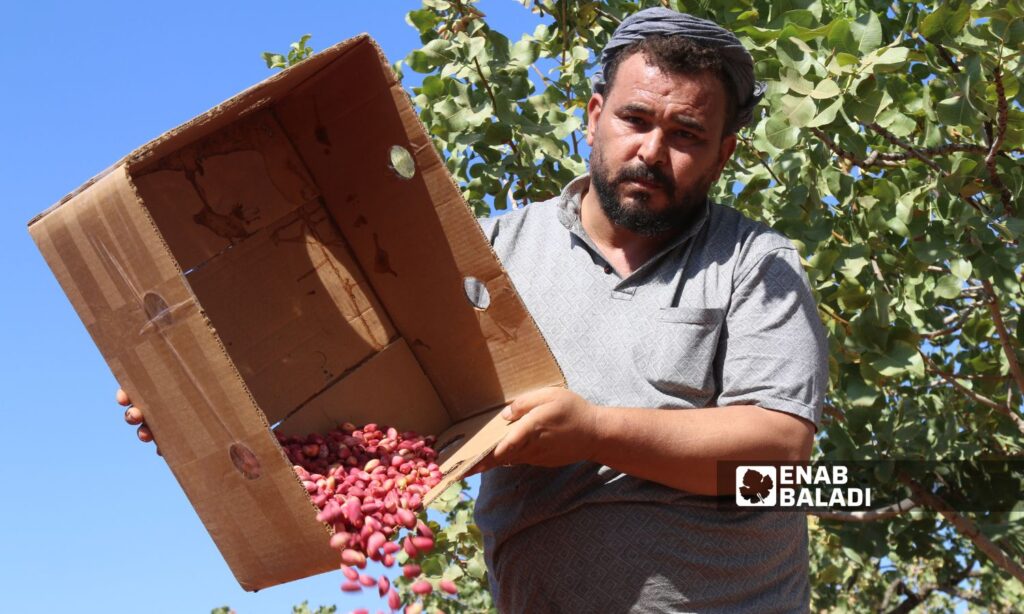Aleppo countryside – Dayan Junpaz
The season for collecting pistachios in the northern countryside of Aleppo began at the start of this August, amidst a decline in crop prices compared to previous years. This has negatively impacted farmers and increased the difficulty of keeping up with rising costs.
The marketing of pistachios, considered a strategic crop or “red gold” as locals call it, is primarily limited to local markets. Exports are carried out through border crossings by traders who exclusively control price determination.
According to farmers interviewed by Enab Baladi, production has declined this season, while the cost for one hectare has reached $1,000 (15 million Syrian pounds).
Traders set the price
The Syrian Interim Government (SIG) does not set the price for pistachios, leaving it to the traders. This means farmers’ profit margins are at the mercy of these traders, as farmers cannot afford the costs of transportation, marketing, and export.
The price per kilo of pistachios ranges from $1.5 to $2 (with $1 equaling 15,000 Syrian pounds and 33 Turkish lira), whereas the price per kilo in 2023 was $3.
Abdul Fattah Sheikho, a farmer from the northern countryside of Aleppo, told Enab Baladi that the drop in pistachio prices this year is primarily due to traders’ monopolization and control over price-setting. Marketing operations are conducted in line with their commercial interests, at the expense of farmers, which has severely limited his profits.
The farmer explained that this season’s production is half of what it was in 2023. Pistachios are known for their cyclical production, being abundant one year and scarce the next.
He mentioned that his land, extending over five hectares, produced only seven tons this year, while the previous year’s productivity was 14 tons.
Additional costs
Hussein Saqqar, a farmer from the village of Kal Jibrin in the Azaz countryside of northern Aleppo, told Enab Baladi that cultivating pistachio trees requires meticulous care, with the cost for one hectare exceeding $1,000.
He explained that he had installed a water network costing $500 per hectare of his land, hoping to achieve greater income and ensure a better agricultural season. However, he only managed to cover the costs of care and farming.
The farmer stated that the success of the pistachio crop depends on several key factors, including planting the trees in yellow soil, regular irrigation, appropriate pesticide use, and periodic pruning.
He mentioned that selecting the appropriate varieties of pistachios is crucial for achieving high productivity. Production rates may vary from one area to another due to changes in weather and environmental conditions, affecting the quality and quantity of the crop.
Several varieties of pistachios are available in the countryside of Aleppo, each with distinct names such as “Batouri,” “Wardini,” “Camel Tooth,” “Turkish,” and “Ashouri,” the most common in the region. Each variety has unique characteristics that affect the crop’s quality, production rates, and prices.
A strategic crop
Pistachio cultivation has expanded in the northern and eastern countrysides of Aleppo over the past years, becoming an alternative for many farmers to their traditional crops like wheat, barley, and legumes despite the high cultivation costs and delayed production years exceeding eight years at least.
According to a statement given to Enab Baladi by Hassan al-Hassan, Director of Agriculture in Aleppo for the Interim Government in September 2023, the pistachio tree holds a significant position among the widespread crops in Aleppo province in general and Jarablus in particular, considered one of the main areas where this cultivation spreads.
Al-Hassan estimated the area planted with pistachios in areas controlled by the Interim Government to be 19,149 hectares and the number of productive trees to be 2,336,178. The 2023 season’s production was estimated at 18,700 tons.
He noted that the pistachio season has economic importance in the region, with its fruits having high nutritional value and its financial returns being good for farmers in rain-fed agriculture areas compared to other crops.

